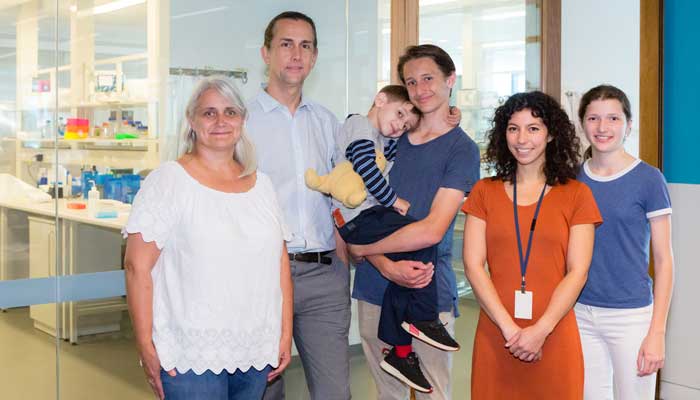If Dr Holly Holliday has ever questioned why she chose a career in medical science, she found her answer earlier this year when she met Nicholas, an eight-year-old boy who may one day benefit from her potentially life-changing research.
A post-doctoral researcher at Garvan Institute of Medical Research in Sydney, Dr Holliday spends most of her days peering down a microscope in a lab. Her recent meeting with Nicholas was her first experience with someone living with neuroblastoma - the disease that her research aims to fight.
“It was very inspiring,” she said. “Meeting Nicholas reinforced for me why I'm in this field.”
“It made me see the bigger picture - instead of just looking at cells in a dish, I was seeing a real-life survivor of neuroblastoma and how his cancer has affected him and his family. It was extremely motivating.”

Dr Holly Holliday (second from right) and Garvan Institute Laboratory Head, Associate Professor Alex Swarbrick (second from left) with Nicholas and his family L-R: Ursula, Nicholas, Luke and Charlotte.
A recent graduate of University of Sydney, Dr Holliday has worked with Garvan since beginning her PhD in 2014 and is and established scientist.
Her research focuses on a new treatment for neuroblastoma, which is a form of cancer made up of cells found in nerve tissues. It typically affects children aged one to five years and those with a high-risk form of the disease have a less than 50 per cent five-year survival rate. Treatment often includes high-dose chemotherapy, the side-effects of which can significantly compromise quality of life. Many survivors go on to suffer chronic health problems, including cardiovascular issues, hearing defects and secondary cancers.
A natural mind for science
Dr Holliday’s scientific ambitions developed at an early age. Her grandfather, famous British molecular biologist Robin Holliday, was one of the first to apply molecular science to the study of ageing and his research helped shape the modern era of genetics. Dr Holliday said his influence help form her early fascination with the possibilities of science.
Born in Australia, Dr Holliday and her family moved to England when she was a baby before they returned to live in Byron Bay when she was six years old.
“It was a great place to grow up, but unfortunately there were no research institutes up there, so I had to run away from the nest,” she said.
“At one point I thought about studying medicine, but I realised that I was more interested in understanding the fundamental biology behind disease, rather than directly working as a doctor in the field of medicine.”
Life-changing science
With vital funding from The Kids’ Cancer Project, Dr Holliday’s research involves exploring microRNA drugs for the treatment of neuroblastoma. MicroRNAs are produced by every cell and their role is to regulate the function of several messenger RNAs, which are responsible for building a cell’s proteins.
When not functioning properly, microRNAs can throw out the balance of normal cell function. Dr Holliday’s research aims to target the dysregulated microRNAs, normalise the genetic pathways and potentially halt the process of the disease.
The research began about seven years ago at Garvan and Dr Holliday started working on the project last year with Associate Professor Alex Swarbrick.

Associate Professor Alex Swarbrick and Dr Holly Holliday at work.
“Our team has screened around 1,200 microRNAs and they’ve discovered some that can kill neuroblastoma cells in a dish, either alone or in combination with chemotherapy,” she said.
“Now I'm taking these microRNAs to see if they can actually work in animal models of human disease. I also analyse the tumours that been treated by the microRNAs to see which pathways are different compared to untreated ones.”
Encouraging results
Early results of the research are positive.
“Our first trial experiment showed that microRNAs can definitely be delivered to the tumours, which is actually quite a difficult thing to do, because they're not very stable,” said Dr Holliday.
“When we analysed the tumours, we found that the microRNAs could actually soften the expression of genes that neuroblastoma cells need in order to grow. It’s really exciting.”
Dr Holliday explains that the direct outcome from her research will be the identification of new microRNA-based drugs for neuroblastoma that may replace, or significantly improve, chemotherapy for children living with the disease.
“We need to do more mouse experiments to show that the microRNAs work in slowing or stopping the tumour growth,” she said. “However, we do know that in a dish, the microRNAs are effective in killing cancer cells and not normal cells, so that's a good starting point. If we can show that it safely works on neuroblastoma in animal models, hopefully it can be translated to the clinic relatively smoothly.”
“Without funding from The Kids’ Cancer Project, I wouldn’t be doing this research,” said Dr Holliday.
“It’s absolutely fundamental to the work that we do and it’s certainly helping us to discover new and innovative treatments that we can hopefully use one day to treat children with neuroblastoma like Nicholas.”